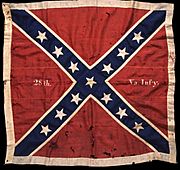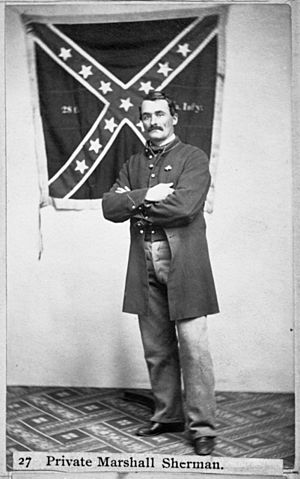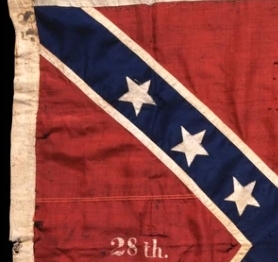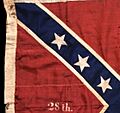28th Virginia battle flag facts for kids
 |
|
| Use |
|
|---|---|
| Proportion | Roughly 1:1 |
| Design | Square red flag bearing a blue saltire with white stars |
The 28th Virginia battle flag is a special flag from the American Civil War. It belonged to a group of soldiers called the 28th Virginia Infantry Regiment. This flag was captured by soldiers from Minnesota during a famous battle called the Battle of Gettysburg. After it was captured, the flag was taken to Minnesota. It was shown at the state's capitol building for many years. Later, it became a permanent part of the Minnesota Historical Society's collection.
Since 1960, different groups in Virginia have asked for the flag to be returned. But Minnesota has always said no. One time, Governor Jesse Ventura of Minnesota even said, "Why? I mean, we won."
The flag was captured at the Battle of Gettysburg by Private Marshall Sherman. He was a soldier from the 1st Minnesota Infantry Regiment. The flag stayed with Sherman in Minnesota. This was even after the United States Department of War listed it in their records in 1867. In 1905, a law was passed saying that Civil War flags should go back to where they came from. But this law did not lead to the flag being returned to Virginia. Virginia and other groups asked for it back many times, in 1961, 1998, 2000, and 2003. In 2013, the governor of Virginia asked to borrow the flag, but this request was also turned down.
Today, the flag is kept safely in a drawer at the Minnesota Historical Society. Its exact location is a secret for security reasons. The flag has some holes, and one of its metal rings (called an eyelet) is torn. But most of the flag is still in good shape. Less than one percent of its fabric is missing.
Contents
Why Flags Mattered in War
During the American Civil War, flags were very important. They helped guide soldiers in battles. Flags also played a big role in how soldiers felt. They showed where a group of soldiers was going and how far they had advanced.
Enemy soldiers would often aim their fire at the people carrying the flags. These people were called standard-bearers. If a standard-bearer was hit, other soldiers nearby would quickly pick up the flag. Because of this, flag designs were made to be easy to see and useful on the battlefield. The Confederate side created a special design for their battle flags. The 28th Virginia battle flag used this design.
How the Flag Was Made
The 28th Virginia battle flag is made from a type of wool fabric called bunting. This wool likely came from the British Isles. It was probably sewn by a woman in the Southern states. She might have used a "flag kit" provided by the army. She might have sewn it for money or because she felt very patriotic.
The white stars and edges sewn onto the flag were likely made from cotton. Over time, the conditions on Civil War battlefields changed the cotton to a brownish color. This happened because of the acidic conditions caused by using black powder.
What the Flag Looked Like
The 28th Virginia battle flag looks like other flags from the Army of Northern Virginia. It is a square red flag. It has a blue "X" shape, called a saltire, with white stars on it. The flag is about 44.5 inches tall and 48 inches wide.
Records suggest that this battle flag was given to George Pickett's division. This happened just a few weeks before the Battle of Gettysburg. The Battle of Gettysburg was the first time this flag was used in a fight.
The Flag's Capture
On the morning of July 3, 1863, Confederate General Robert E. Lee ordered a big attack. This attack was part of the Battle of Gettysburg. It is known as Pickett's Charge. The 28th Virginia Infantry Regiment was part of this attack. They were in a group led by Brigadier General Richard B. Garnett.
The Union soldiers were higher up and ahead of the Confederates. They started firing. But the Confederate soldiers pushed forward. They even reached a place on Cemetery Ridge that is now called the high-water mark of the Confederacy. However, more Confederate soldiers did not arrive to help. Union troops then moved into the gaps.
The Union's 1st Minnesota Infantry Regiment was told to attack the side of the Confederate troops. They did this while protecting their own flag. More than 70% of the Minnesota soldiers were killed, wounded, or captured in this battle.
During this attack, Sergeant John Eakin of the 28th Virginia was shot three times. He was carrying the 28th Virginia battle flag. Another soldier was immediately shot after picking up the flag. Then, Colonel Robert Allen picked it up and was also badly wounded. Allen handed the flag to Lieutenant John Lee. Lee stepped onto a Union wall and started waving the flag. The flag's pole was shot, but Lee picked the flag back up. He kept waving it even after he was wounded.
The 28th Virginia battle flag was then captured by Private Marshall Sherman. He was from the 1st Minnesota Infantry Regiment. Sherman later received the Medal of Honor for his brave actions. There are different stories about how he captured the flag.
Sherman's Story
After the Battle of Gettysburg, Marshall Sherman told a reporter his story. He said he ran right at Confederate Lieutenant John Lee. He held his bayonet (a knife on the end of a rifle) very close to Lee's chest. Sherman said, "Throw down that flag or I'll run you through!" According to Sherman, Lee paused. Sherman shouted again, and Lee dropped the flag. Lee then put his hands up. Sherman said he picked up the flag and took Lee as a prisoner.
Daniel Bond's Story
Daniel Bond was another private in the 1st Minnesota Infantry Regiment. His story is different from Sherman's. Bond said that the flag was seen resting against a tree, with no one guarding it. Bond said Sherman got the flag by running to it faster than he could.
What Happened to the Flag Next
In October 1864, the United States Department of War decided that all captured Confederate flags belonged to the United States. They had to be given to the Department to be recorded. The number 58 was written on the 28th Virginia battle flag. This shows that Sherman gave it to the Department before 1867.
Who Should Keep the Flag?
1800s
In 1887, a group of Civil War veterans from Pennsylvania planned a reunion. They suggested returning Confederate battle flags from three units, including the 28th Virginia battle flag. They hoped this would encourage Confederate veterans to come to the reunion. Grover Cleveland, who was the president of the United States at the time, supported this idea.
However, many Union veterans did not like the idea. Some Southerners also disagreed. Even the Governor of Virginia, Fitzhugh Lee, who was a Confederate veteran and nephew of Robert E. Lee, was against it. Jefferson Davis said the flags belonged to the states that captured them. He felt returning them would go against military rules. President Cleveland eventually changed his mind. The reunion happened without the flags being returned.
In 1888, the War Department's records said the flag was "supposed to have been loaned and never returned." It's thought that Alexander Ramsey might have taken it to Minnesota. He was the secretary of the War Department from 1879 to 1881. He later became the first president of the Minnesota Historical Society. Another idea is that Sherman kept the flag himself. But this doesn't explain why it was recorded by the War Department in 1867. A picture of Sherman with the flag in Saint Paul in early 1864 supports the idea that he kept it.
After it was returned to Minnesota, the flag was sometimes shown at the Minnesota State Capitol. Sherman likely lent it for these displays. It was shown at Sherman's funeral in 1896. Since it wasn't mentioned in his will, it became a permanent part of the Minnesota Historical Society's collection.
1900s
In 1905, the United States Congress passed a law. It said that captured Civil War flags should be returned to where they came from. This law was meant to celebrate the friendship between the Northern and Southern states. But the 28th Virginia battle flag could not be returned. This was because the War Department did not have it.
As early as 1960, people in Virginia wanted the 28th Virginia battle flag back. In 1961, Virginia officially asked for the flag to be returned. This was for the 100th anniversary of the Civil War. But it was not returned. The director of the Minnesota Historical Society said that the actions of the 1st Minnesota Infantry Regiment were a very proud moment for Minnesota. He argued that the flag was more historically important if it stayed in Minnesota.
In 1998, Civil War reenactors in Virginia asked for the flag back. They wanted it before the 135th anniversary of the Battle of Gettysburg. A man named Chris Caveness led this group. He found the 1905 law and thought it meant Virginia had a right to the flag. But the flag was not returned. Skip Humphrey, who was the Attorney General of Minnesota then, said Virginia had no legal right to the flag. He also said the flag could not be considered stolen because of a time limit in Minnesota law.
In 2000, some members of the Virginia General Assembly asked for the flag to be returned. They were inspired by Caveness's group. They created a resolution (a formal statement) and brought it to the Virginia Senate. One of the people who supported it, John S. Edwards, said returning the flag was "a matter of state pride." Ian Stewart, from the Minnesota Historical Society, disagreed. He said the flag was just as important to Minnesota. He stated, "Unless there's a compelling legal reason to return it, we are not inclined to do so." The Virginia Senate approved the resolution.
[The flag] was taken in a battle with the cost of the blood of all these Minnesotans. It would be a sacrilege to return it to [Virginia]. It's something that was earned through the incredible courage and valor of the men who gave their lives and risked their lives to obtain it.
After the 2000 resolution from Virginia, Minnesota Governor Jesse Ventura said, "Why? I mean, we won." He added, "We took it, that makes it our heritage."
2000s and Beyond
In 2002, John S. Brown, a military history expert, said the flag should be in a military museum in Virginia. But the flag was not returned. In 2003, officials in Virginia, including Governor Mark Warner, demanded the flag back. Minnesota Governor Tim Pawlenty replied that Virginia was "not getting it. […] We believe it's rightfully ours, and we're not giving it back to Virginia."
In 2013, 150 years after the Battle of Gettysburg, the governor of Virginia asked to borrow the flag. Minnesota Governor Mark Dayton said no.
The Flag's Condition Today
Photos of the 28th Virginia battle flag show that very little of its fabric is missing. Less than one percent is gone. The middle eyelet (metal ring) is torn. There are about 12 holes in the red parts of the flag. Some holes are also in the border of the fly end (the part that waves).
The flag has not been tested for blood. However, some reports have said it has bloodstains. The flag is kept in a drawer inside a cabinet at the Minnesota Historical Society. Its exact location is kept secret for security reasons.
Images for kids





